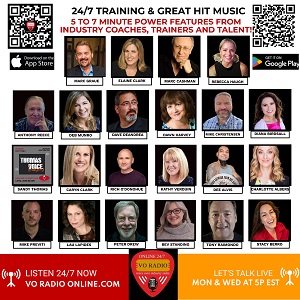|
VOICE ACTING How To Create And Generate Different Levels Of Emotion Quickly And Naturally  By Monique Sacay-Bagwell By Monique Sacay-BagwellVoice Actor & Professor of Media and Communications As Maya Angelou said, "People forget what you said...
but they won't forget how you made them feel." If we deliver copy
without making an emotional connection to it, the message will not have
the intended impact on our listener or audience. In voice over, we sometimes have
quick turnaround times and need to be able to connect instantly with an
underlying emotion of the copy, or we may need to move rapidly between
emotional states when recording multiple characters as in audiobooks. Voice over is not devoid of emotions no matter the genre. EMOTION: QUICKLY AND NATURALLY As
an actress, I think it is important to continue exercising your creativity so
you can respond instinctively and honestly in your work. As a director,
teacher and coach, I like having a variety of techniques to pull from when
working with actors, and discovered a method that allows me to create and generate different levels of emotion
quickly and naturally. I first learned about the Emotional Body® Method in the mid-90's at a
Theatre Conference in San Francisco where Susanna Bloch, one of the original
developers of this technique, first introduced it to the acting community. It explores the evidence-based Emotional Effector Patterns (EEP) found in six basic emotions. Each of the EEP emotions have their own unique breath, facial expression and posture. When a person somatically connects with these patterns they can naturally trigger these emotions. And I have used this technique in many situations
from theatre to voice over. WAS EMOTIONALLY HUNG OVER I came from a Stanislavski Acting background, where you
would delve deeply into the psyche of your character and your own experiences
to make emotional connections. So much so, that I would often be emotionally
hung over weeks, even months after a show closed, especially if the role was
an intense drama. As you can imagine, this was exhausting and could affect a
person's mental well-being. What attracted me to the Emotional Body technique
is how I could organically trigger emotional reactions just by connecting
with the scientifically supported effector patterns. Plus, the technique
includes and encourages a process of stepping out of the emotional states to
avoid Emotional Hangover. It
has become a valuable performance tool in my character and audiobook work. FOR EXAMPLE ...  Laura Bond (pictured) founder of the Emotional Body Method, explains that it "Provides an efficient and
effective method of emotion regulation and shifting emotional states
quickly at will." Laura Bond (pictured) founder of the Emotional Body Method, explains that it "Provides an efficient and
effective method of emotion regulation and shifting emotional states
quickly at will." Performers are
often playing roles where their characters must react to intense
emotional situations in an instant. One example that comes to mind where
using the Emotional Body Method EEP technique helped me in voice over, was when I had to
perform multiple characters in an highly charged scene
in an audiobook. It was a scene between two lovers who were trying to
heal as a couple after the female was recovering from a viscous rape
attack. During this scene, the male character was trying to remain calm
and caring, while the female character was going
through a major breakdown of emotions. I had to move quickly between
emotional states of varying levels of intensity of fear to anger to
sadness for the female, and then tenderness to fear to sadness for the
male, with moments of neutrality as the narrator. Because of my work with EEP, I was able to connect with each of these
emotions - using breath, posture and facial expressions quickly, thereby
performing them with the emotional athleticism needed for this scene.
FOR CORPORATE COPY, TOO Another example comes
from when I was teaching the Emotional Body Method EEP technique workshop at the VOAtlanta conference. I was coaching a
voice over actress on how to use the method in her Corporate copy. The copy
required her to sound confident and strong. However,
her read was weak and fearful, even though her posture was
tall and she was smiling. During her second round of reading, I closely
observed that her facial expression had the subtle signs of the
EEP pattern of fear with her eyes wide, and also the
EEP pattern of sadness with her pinched brow. She was displaying what
is termed as an "entanglement," where you think you are communicating
one emotion, but your facial expression is communicating another. To
combat this, I coached her into an EEP pattern
of tenderness, which helped soften her eyes, slow down breathing, relax tension in her brow, and offer a slight, warm
smile. Her tone immediately shifted to the confident and
self-assured person the copy was calling for. Interestingly,
the voice over actress later shared an additional discovery after doing this
technique. She said that she is often not taken seriously at her
workplace, and that she now realizes that her facial expressions were
likely to be the reason. EASY TO LEARN Bond points
out that since the Emotional Body Method EEP focuses on a "small number of basic emotional
patterns" it makes it easy to learn and remember within a "reasonable
time."
When learning EEP,
students explore the facial expression, breath, and postural attitudes
of the six basic emotions that have been scientifically and universally
explored. Once voice actors have developed a strong
connection with each, they can begin to recognize emotional
entanglements within themselves, and eventually learn how to work with
levels, and blend or mix emotions. In addition, all EEP work starts
with learning the 'neutral' breath pattern, which Bond explains helps provide "restorative and calming
practices" that enable the performer to "step in and out of demanding
roles" - and thus avoid the emotional hangovers that have plagued our
entertainment industry.
Due to the sensitive
nature of this work, it is highly recommended to learn from a qualified and vetted
instructor. They are better equipped to guide
a person through the six EEP emotional patterns. And once you learn the
EEP technique, you will begin to find many ways it can be applied
outside of performance, including becoming more mindful and emotionally
aware. Note: Laura Bond, founder of the Emotional Body Method, teaches the method online via Zoom. The next class - held every other Sunday - begins July 10, 2022. For details, visit www.EmotionalBody.co. ------------------------- ABOUT MONIQUE Monique
Sacay-Bagwell is a Full Professor of Media and Communications at Lander
University in Greenwood, SC, where she has been teaching speech and performance studies for over
30 years. When she isn't behind the
podium, she is actively involved in the performing arts as an actress, stage
director and voice over artist. She has
won numerous awards and recognitions for her work as an actress, director, and
educator. Her degrees include: A.S. in
Speech and Theatre, Kingsborough Community Theatre; B.F.A. in Performance,
Brooklyn College; M.F.A. in Performance, The Ohio State University. Her
specializations are in Performance training, Directing, Speech, Voice Over
Acting and General American English. She is also an Associate Instructor for the Emotional Body Method, where she teaches the Emotional Effector Patterns (EEP). Her voice over work includes audiobook narration heard on
Audible, Amazon, and iTunes; telephony, corporate narration, eLearning, and podcasting. -------------------------------- ABOUT LAURA BOND Laura Bond
is a Full Professor of Drama and Interdisciplinary Studies at UNC Asheville,
teaching acting and emotional expression. She specializes in somatic education
and its relationship to evidence-based emotional effector patterns (EEP). After
20 years of practice-research collaborating with Feldenkrais® practitioners
and research psychologist Susana Bloch, an original EEP researcher, she
founded the Emotional Body® Method. Bond develops specialty lessons to assist
individuals in expanding expressive capabilities and somatic resiliency. She is
the author of TEAM For Actors: A Holistic Approach to Embodied Acting and The
Emotional Body: A Method for Physical Self Regulation. Web: www.emotionalbody.co |
|
|
Tell Us What YOU Think!
Please Note: Since we check for spam, there will be a slight delay in the actual posting of your comment.
Comments
No comments have been posted yet. Hurry, and you could be the first!


.gif)




.png)


click for new article alerts